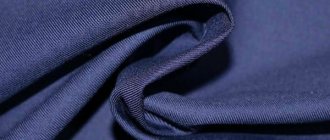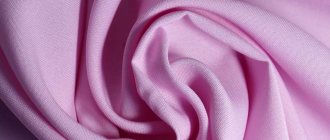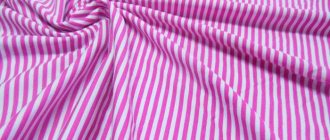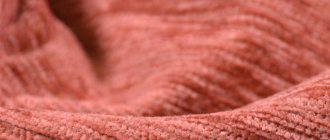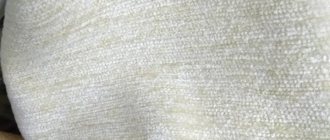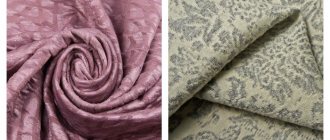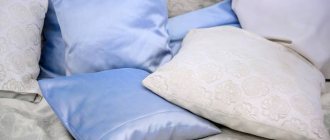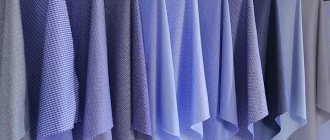Polyester microfiber is a very thin, durable, unique material. Its distinctive feature is its texture. Polyester fiber has many irregularities.
Polyester fibers increase the surface area of the material. In addition, the structure of artificial fibers ensures its anti-slip properties. This makes it possible to use the material in many areas, from the textile industry to cleaning.
The use of microfiber allows you to create unique sportswear and effective skin care products (sponges, napkins, etc.). The material is also used as bedding filler.
Description and composition of fabric
Microfiber is a unique fabric, thin and durable at the same time. In the middle of the last century, the Japanese developed a method for producing ultra-thin threads at that time - about 0.7 denier.
After 20 years, a new material “Ultrasyud” was presented, the technology for obtaining it was classified. By the 90s, microfiber was presented at an exhibition in Switzerland. Fabric has entered everyday life, finding more and more areas of application.
The material can be based on cotton, viscose, polyester and polyamide fibers. Their combination allows you to obtain different types of microfiber that differ in properties.
Microfiber production involves creating fibers that are 300 times thinner than human hair. They are woven in 50–150 pieces, obtaining a thread that resembles a star in cross-section. Then the canvas is formed. If we decompose 1 cm2 of fabric into components, the length of the threads will exceed 1 km.
Thanks to this structure, a static charge arises inside the material, attracting and holding the smallest particles of dust.
Description, advantages and disadvantages of microfiber for bed linen
The material has gained popularity due to its unique characteristics that make it universal.
- Wear-resistant - tear-resistant, does not wear out, does not fade, and is not subject to destruction.
- Hygroscopic - absorbs a large amount of liquid, since the fiber structure has a huge number of tiny pores.
- Breathable - air passes through it as easily as moisture.
- Hypoallergenic - the structure of the fiber does not allow microorganisms to grow and dust particles to accumulate.
Synthetic composition Microfiber
Microfiber is composed of polyamide and polyester fibers and is a synthetic material. In terms of properties, it is practically not inferior to natural ones, and in many ways even surpasses them.
Knitted microfiber and fabric are produced; home textiles are sewn from both varieties, but most often from fabric. But various bedspreads, rugs and household items are usually knitted.
The advantages of microfiber bedding include the following characteristics.
- Pleasant - the fabric is soft to the touch, with a silky, smooth texture.
- Durable - no pills form on it, it does not wear out, does not wrinkle, does not deform.
- Decorative – does not fade or fade, remaining bright and beautiful regardless of the intensity of use.
- Neutral – does not generate static electricity.
- Unpretentious - does not wrinkle, washes easily, dries quickly.
- Affordable - the cost of the set is significantly lower than that of a similar set made from natural materials.
In the photo - microfiber bedding:
The disadvantages include some features of the material.
- Do not dry on heating devices, which is very popular in winter.
- Do not wash in hot water.
- Short service life (from 2 to 5 years).
The rest of the claims usually made about microfiber linen are more likely to relate to blunders of unscrupulous manufacturers. Either they pass off low-grade synthetics, dyed with a toxic color, as microfiber, or they use the labor of not the most qualified personnel from neighboring countries and “delight” the consumer with skewed “masterpieces”.
Belarusian terry sheets are of good quality.
What are the benefits of fabric curtains for the bathroom?
Approximate prices for bamboo curtains: .
In order not to give away your hard-earned money for a samopal, when purchasing, carefully study the packaging. Normal manufacturers print all the information the buyer is interested in, and even provide a link to the company’s website. But if there is only the name of a murky LLC on the package, it is better to refuse, even at the most tempting price.
Trying to make money, businessmen do not disdain harmful dyes and industrial fabrics. If after purchase the kit fades a lot or even stains the body and accessories, it’s easier to throw it on rags. And if there is also a persistent chemical smell, then there are no options, there is no need to risk your health.
Types of microfiber
According to the production method, the canvas is divided into types:
- Woven. A special weave of fibers is used.
- Non-woven. The threads do not intertwine.
- Knitted. The result is a dense, voluminous fabric that is convenient for cleaning and washing the car.
- Imitation suede. Particularly dense weaving is suitable for sewing clothes.
According to the technologies used, the following are distinguished:
- Micromodal (see modal material). Bamboo pulp is used for production. The fabric is durable and soft. The main purpose is sewing bed linen and clothes.
- Meryl. Treated with silver, it has bactericidal properties. Underwear is made from it.
- Tactel. It is made of polyamide, which makes the material delicate and pleasant to the body.
Tactel is divided into types:
- Micro. It is distinguished by its ability to stretch and resistance to getting wet. Used for the production of raincoats, tents, tights.
- Multisoft. It has a unique cross-section, due to which matte and glossy canvases are obtained. Used to create clothes, pillowcases, sheets, duvet covers.
- Strata. Threads with different diameters are used. When painting, the paint settles unevenly, resulting in a three-dimensional pattern.
- Diablo. Reflects light, soft, moderately shiny option. Underwear is made from it.
- Aquator. Protects from wind and moisture, yet breathes and dries quickly.
- Textural. Dense, rough-looking, but soft material. Suitable for sewing sportswear.
- Climate. Keeps skin fresh and conducts air.
See fabric review:
Material advantages
If you are interested in a microfiber pillow, then you will be interested to know about its advantages. These include:
- High level of softness, but at the same time the material is quite elastic. It is comfortable to sleep on and is suitable for people with neck or musculoskeletal problems.
- No odor, hypoallergenic. The pillow is completely safe and does not harbor bed mites. It is suitable for both children and adults.
- Good thermal insulation. The material retains heat in the cold season and dissipates it in the summer. Sleeping on it is convenient and comfortable.
- Long service life. Microfiber quickly takes its original shape, does not come out, does not degrade or shrink over time.
- Affordable price. Since this is a polymer material, its cost is significantly lower than that of natural material. Purchasing such products will not hit the family budget.
- Light weight. The pillow is almost not felt, it does not take up much space when stored. Also, the material does not accumulate odors and removes moisture well.
- Easy to care for. This material is washable. If he does sit down, it’s easy to just add a new portion to the pillow.
A microfiber pillow is an ideal choice for the home. It is practical, inexpensive and elastic enough that even large people can sleep on it.
Advantages and disadvantages of the material
The fabric is harmless to use. The positive aspects of microfiber:
- durable;
- penetrates into small holes on objects, collecting dust, moisture and holding fabrics inside;
- has no smell;
- environmentally friendly;
- safe;
- conducts air;
- does not lose color;
- dries quickly;
- lasts longer than other fabrics by 5 years;
- does not wrinkle;
- capable of absorbing moisture 300% better than other materials.
Cons of microfiber:
- pellets form;
- loses its ability to retain moisture;
- causes allergies;
- attracts hairs and threads;
- gets dirty quickly with grease;
- does not tolerate hot water and air;
- high price.
There are fakes on the market that do not have the range of advantages of natural microfiber. Tips for choosing microfiber:
- the fabric is evenly colored;
- the label indicates the appropriate care instructions;
- The material is soft and pleasant to the touch.
The price of microfiber cannot be low.
Disadvantages of microfiber pillows
When it comes to the negative aspects of microfiber pillows, most often their presence is due to the dishonesty of the manufacturer himself, who uses low-quality and cheap raw materials.
- No matter how high the anti-deformation properties of the product’s fibers are, it should be kept away from harmful sources , namely fire, radiators and boiling water.
- Particular care should be taken when choosing a washing mode . The optimal water temperature for microfiber should not exceed 30°C, and it is advisable to limit subsequent ironing to the lowest temperature.
- The ability of the fabric to retain moisture results in the fact that microfiber no less reliably begins to accumulate and fix fat, which is why the pillow quickly loses all its wear-resistant qualities. Under such circumstances, its service life will be no more than 5 years .
- There are a lot of fakes, the production of which does not require compliance with the required rules and regulations. As a result, a recently purchased product, after the first wash, begins to actively fade, become deformed and emit an unpleasant odor.
Areas of application of the material
What is produced from microfiber:
- wipes for cleaning the house, cleaning office equipment;
- clothes for everyday wear and sportswear;
- mops;
- industrial filters;
- tourist equipment - tents, sleeping bags;
- towels;
- sponges for washing dishes;
- moisture-retaining mats;
- tights;
- underwear.
See a review of car drying products:
The main purpose of microfiber is cleaning premises. She reupholsters furniture, upholsters chairs and sofas.
Features of fabric care
Rules for washing the material in a washing machine or by hand:
- water temperature – up to 40 °C;
- neutral detergent;
- number of revolutions – up to 800;
- Do not twist too much when squeezing.
It is better to air dry the fabric. Microfiber does not require ironing, but if such a need arises, the “silk” mode is used.
It is unacceptable to use bleaches, stain removers, or dry on central heating radiators.
Advantages of synthetic fillers
Hypoallergenic, easy to care for, affordable price - a combination of characteristics that ensure the successful replacement of natural padding with artificial fillers. And these are not all the advantages of modern synthetics.
Holofiber
The filler is a polyester fiber twisted into a spiral. In appearance and characteristics, the material resembles cotton, but due to the presence of air cavities it is more elastic.
Advantages of holofiber stuffing.
- Soft and moderately elastic material.
- Hypoallergenic fiber with good hygroscopic and breathable properties.
- Products made from it are light and airy.
- Can be washed and dried in a washing machine.
Cons of holofiber.
- As it is used, the packing gradually loses its elasticity and cakes. Service life is limited to 4–5 years.
Additionally, holofiber fibers are treated with silicone, which makes them glide and not wrinkle
Polyester microfiber
The structure and texture of thin and durable threads, which in many respects have the properties of natural materials, clearly demonstrate nanotechnology in action. It is considered an artificial analogue of bird fluff.
Advantages of the material.
- Soft, elastic, does not cake.
- Lets air through.
- Does not cause allergies, bioresistant, antistatic.
- Provides thermoregulation and retains heat.
- Can be washed at home and dries quickly.
Disadvantages of polyester fiber.
- Too soft, does not support the spine in a physiologically correct position.
- Poorly absorbs moisture.
Products stuffed with artificial “swan’s down” retain the advantages of their natural counterpart, but are free from its disadvantages.
Memory foam
Polyurethane foam Memory foam (with memory effect) is a modern filler for orthopedic products. Under the influence of heat and pressure, it adapts to the human body, but “remembers” its original shape and restores it in a few seconds.
Advantages of innovative material.
- Made from natural, environmentally friendly polymers.
- Supports the physiological curves of the spine.
- Does not cause allergies, repels dust, is bioresistant, breathable.
Disadvantages of polyurethane foam.
- Such pillows cannot be washed, otherwise the product will lose its memory.
- High price.
The pillow comes with a cover made of natural fabric, which increases the comfort of the product.
When choosing pillows, consider the needs of each family member.
For allergy sufferers and children, exclude feather and wool fillings. Teach teenagers to sleep on orthopedic products - this is the key to spinal health. For guests, it is better to purchase synthetic pillows - they will have to be washed more often. Breathable and hygroscopic materials are more comfortable than airtight materials. Don't forget about the lifespan of the packing. Sweet dreams!
How to choose a pillow for sleeping
May 15, 2021 |
Sport. Dream. Health

